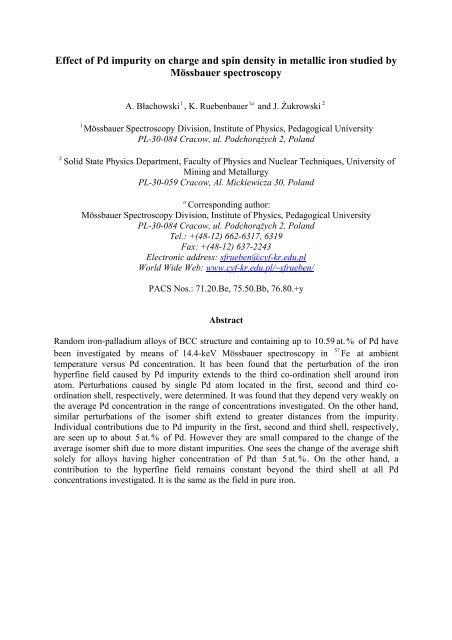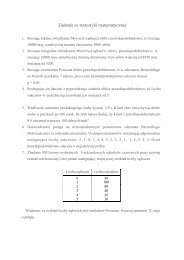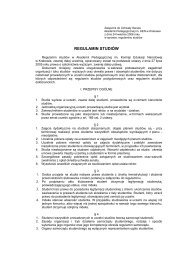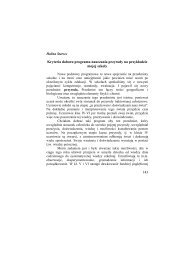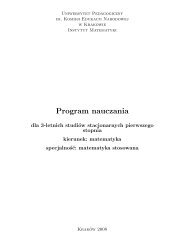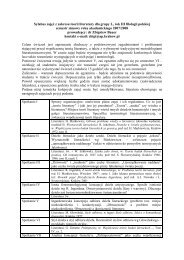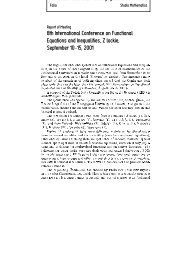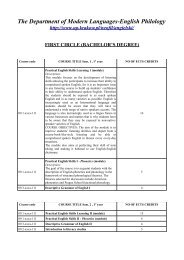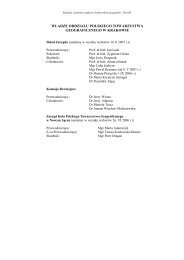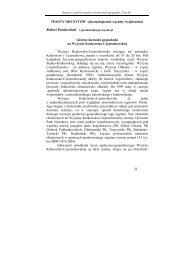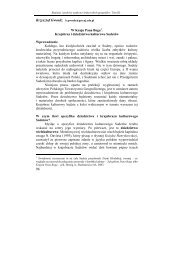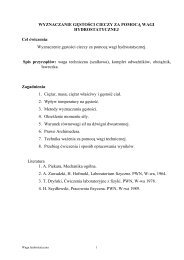Effect of Pd impurity on charge and spin density in metallic iron ...
Effect of Pd impurity on charge and spin density in metallic iron ...
Effect of Pd impurity on charge and spin density in metallic iron ...
You also want an ePaper? Increase the reach of your titles
YUMPU automatically turns print PDFs into web optimized ePapers that Google loves.
<str<strong>on</strong>g>Effect</str<strong>on</strong>g> <str<strong>on</strong>g>of</str<strong>on</strong>g> <str<strong>on</strong>g>Pd</str<strong>on</strong>g> <str<strong>on</strong>g>impurity</str<strong>on</strong>g> <strong>on</strong> <strong>charge</strong> <strong>and</strong> <strong>sp<strong>in</strong></strong> <strong>density</strong> <strong>in</strong> <strong>metallic</strong> ir<strong>on</strong> studied by<br />
Mössbauer spectroscopy<br />
A. Błachowski 1 , K. Ruebenbauer 1a<br />
<strong>and</strong> J. Żukrowski 2<br />
1 Mössbauer Spectroscopy Divisi<strong>on</strong>, Institute <str<strong>on</strong>g>of</str<strong>on</strong>g> Physics, Pedagogical University<br />
PL-30-084 Cracow, ul. Podchorążych 2, Pol<strong>and</strong><br />
2 Solid State Physics Department, Faculty <str<strong>on</strong>g>of</str<strong>on</strong>g> Physics <strong>and</strong> Nuclear Techniques, University <str<strong>on</strong>g>of</str<strong>on</strong>g><br />
M<strong>in</strong><strong>in</strong>g <strong>and</strong> Metallurgy<br />
PL-30-059 Cracow, Al. Mickiewicza 30, Pol<strong>and</strong><br />
a Corresp<strong>on</strong>d<strong>in</strong>g author:<br />
Mössbauer Spectroscopy Divisi<strong>on</strong>, Institute <str<strong>on</strong>g>of</str<strong>on</strong>g> Physics, Pedagogical University<br />
PL-30-084 Cracow, ul. Podchorążych 2, Pol<strong>and</strong><br />
Tel.: +(48-12) 662-6317, 6319<br />
Fax: +(48-12) 637-2243<br />
Electr<strong>on</strong>ic address: sfrueben@cyf-kr.edu.pl<br />
World Wide Web: www.cyf-kr.edu.pl/~sfrueben/<br />
PACS Nos.: 71.20.Be, 75.50.Bb, 76.80.+y<br />
Abstract<br />
R<strong>and</strong>om ir<strong>on</strong>-palladium alloys <str<strong>on</strong>g>of</str<strong>on</strong>g> BCC structure <strong>and</strong> c<strong>on</strong>ta<strong>in</strong><strong>in</strong>g up to 10.59 at. % <str<strong>on</strong>g>of</str<strong>on</strong>g> <str<strong>on</strong>g>Pd</str<strong>on</strong>g> have<br />
57<br />
been <strong>in</strong>vestigated by means <str<strong>on</strong>g>of</str<strong>on</strong>g> 14.4-keV Mössbauer spectroscopy <strong>in</strong> Fe at ambient<br />
temperature versus <str<strong>on</strong>g>Pd</str<strong>on</strong>g> c<strong>on</strong>centrati<strong>on</strong>. It has been found that the perturbati<strong>on</strong> <str<strong>on</strong>g>of</str<strong>on</strong>g> the ir<strong>on</strong><br />
hyperf<strong>in</strong>e field caused by <str<strong>on</strong>g>Pd</str<strong>on</strong>g> <str<strong>on</strong>g>impurity</str<strong>on</strong>g> extends to the third co-ord<strong>in</strong>ati<strong>on</strong> shell around ir<strong>on</strong><br />
atom. Perturbati<strong>on</strong>s caused by s<strong>in</strong>gle <str<strong>on</strong>g>Pd</str<strong>on</strong>g> atom located <strong>in</strong> the first, sec<strong>on</strong>d <strong>and</strong> third coord<strong>in</strong>ati<strong>on</strong><br />
shell, respectively, were determ<strong>in</strong>ed. It was found that they depend very weakly <strong>on</strong><br />
the average <str<strong>on</strong>g>Pd</str<strong>on</strong>g> c<strong>on</strong>centrati<strong>on</strong> <strong>in</strong> the range <str<strong>on</strong>g>of</str<strong>on</strong>g> c<strong>on</strong>centrati<strong>on</strong>s <strong>in</strong>vestigated. On the other h<strong>and</strong>,<br />
similar perturbati<strong>on</strong>s <str<strong>on</strong>g>of</str<strong>on</strong>g> the isomer shift extend to greater distances from the <str<strong>on</strong>g>impurity</str<strong>on</strong>g>.<br />
Individual c<strong>on</strong>tributi<strong>on</strong>s due to <str<strong>on</strong>g>Pd</str<strong>on</strong>g> <str<strong>on</strong>g>impurity</str<strong>on</strong>g> <strong>in</strong> the first, sec<strong>on</strong>d <strong>and</strong> third shell, respectively,<br />
are seen up to about 5 at. % <str<strong>on</strong>g>of</str<strong>on</strong>g> <str<strong>on</strong>g>Pd</str<strong>on</strong>g>. However they are small compared to the change <str<strong>on</strong>g>of</str<strong>on</strong>g> the<br />
average isomer shift due to more distant impurities. One sees the change <str<strong>on</strong>g>of</str<strong>on</strong>g> the average shift<br />
solely for alloys hav<strong>in</strong>g higher c<strong>on</strong>centrati<strong>on</strong> <str<strong>on</strong>g>of</str<strong>on</strong>g> <str<strong>on</strong>g>Pd</str<strong>on</strong>g> than 5 at. % . On the other h<strong>and</strong>, a<br />
c<strong>on</strong>tributi<strong>on</strong> to the hyperf<strong>in</strong>e field rema<strong>in</strong>s c<strong>on</strong>stant bey<strong>on</strong>d the third shell at all <str<strong>on</strong>g>Pd</str<strong>on</strong>g><br />
c<strong>on</strong>centrati<strong>on</strong>s <strong>in</strong>vestigated. It is the same as the field <strong>in</strong> pure ir<strong>on</strong>.
1. Introducti<strong>on</strong><br />
The Mössbauer spectroscopy is sensitive to the electr<strong>on</strong> <strong>charge</strong> <strong>density</strong> <strong>on</strong> the res<strong>on</strong>ant nuclei<br />
via isomer shift, <strong>and</strong> it is simultaneously sensitive to the electr<strong>on</strong> <strong>sp<strong>in</strong></strong> <strong>density</strong> <strong>on</strong> the res<strong>on</strong>ant<br />
nuclei via dipolar magnetic hyperf<strong>in</strong>e <strong>in</strong>teracti<strong>on</strong> provided the sample rema<strong>in</strong>s magnetically<br />
ordered. Hence <strong>on</strong>e can look at the <strong>charge</strong> <strong>and</strong> <strong>sp<strong>in</strong></strong> <strong>density</strong> modificati<strong>on</strong>s due to the <strong>charge</strong><br />
<strong>and</strong> <strong>sp<strong>in</strong></strong> transfer from adjacent atoms surround<strong>in</strong>g the res<strong>on</strong>ant atom. If <strong>on</strong>e collects data at<br />
relatively low temperature <str<strong>on</strong>g>of</str<strong>on</strong>g> the sample <strong>in</strong>vestigated, i.e., well below magnetic order<strong>in</strong>g<br />
temperature <strong>on</strong>e looks approximately at the properties <str<strong>on</strong>g>of</str<strong>on</strong>g> the ground electr<strong>on</strong>ic state <str<strong>on</strong>g>of</str<strong>on</strong>g> the<br />
system. C<strong>on</strong>ducti<strong>on</strong> electr<strong>on</strong>s play dom<strong>in</strong>ant role <strong>in</strong> the <strong>charge</strong> <strong>and</strong> <strong>sp<strong>in</strong></strong> transfer <strong>in</strong> <strong>metallic</strong><br />
systems. A particularly simple situati<strong>on</strong> is achieved <strong>in</strong> a ferromagnetic host composed <str<strong>on</strong>g>of</str<strong>on</strong>g><br />
rather localised atomic magnetic moments provided res<strong>on</strong>ant atoms are <strong>on</strong>e <str<strong>on</strong>g>of</str<strong>on</strong>g> the host<br />
isotopes distributed r<strong>and</strong>omly between other n<strong>on</strong>-res<strong>on</strong>ant host atoms. Such situati<strong>on</strong> occurs<br />
<strong>in</strong> BCC ir<strong>on</strong>.<br />
In order to ga<strong>in</strong> some <strong>in</strong>formati<strong>on</strong> about the range <str<strong>on</strong>g>of</str<strong>on</strong>g> the <strong>charge</strong> <strong>and</strong> <strong>sp<strong>in</strong></strong> transfer between<br />
atoms <strong>on</strong>e can <strong>in</strong>troduce some n<strong>on</strong>-magnetic <str<strong>on</strong>g>impurity</str<strong>on</strong>g> distributed at r<strong>and</strong>om <strong>in</strong> the host. Low<br />
c<strong>on</strong>centrati<strong>on</strong>s <str<strong>on</strong>g>of</str<strong>on</strong>g> impurities are essential to avoid <strong>in</strong>teracti<strong>on</strong>s between them. Investigati<strong>on</strong> <str<strong>on</strong>g>of</str<strong>on</strong>g><br />
several samples with vary<strong>in</strong>g c<strong>on</strong>centrati<strong>on</strong> <str<strong>on</strong>g>of</str<strong>on</strong>g> impurities allows for better <strong>in</strong>sight <strong>in</strong>to the<br />
problem. An <str<strong>on</strong>g>impurity</str<strong>on</strong>g> affects <strong>charge</strong> <strong>and</strong> <strong>sp<strong>in</strong></strong> densities <str<strong>on</strong>g>of</str<strong>on</strong>g> the c<strong>on</strong>ducti<strong>on</strong> electr<strong>on</strong>s, <strong>and</strong> these<br />
perturbati<strong>on</strong>s have impact <strong>on</strong> the observed isomer shift <strong>and</strong> hyperf<strong>in</strong>e magnetic field. In the<br />
case <str<strong>on</strong>g>of</str<strong>on</strong>g> the very l<strong>on</strong>g distance perturbati<strong>on</strong>s <strong>on</strong>e sees the change <str<strong>on</strong>g>of</str<strong>on</strong>g> the average shift <strong>and</strong> field<br />
solely. Otherwise a distributi<strong>on</strong> <str<strong>on</strong>g>of</str<strong>on</strong>g> the shifts <strong>and</strong> fields builds-up with the <strong>in</strong>creas<strong>in</strong>g<br />
c<strong>on</strong>centrati<strong>on</strong> <str<strong>on</strong>g>of</str<strong>on</strong>g> diluted impurities due to various possible c<strong>on</strong>figurati<strong>on</strong>s around the res<strong>on</strong>ant<br />
atom [1].<br />
Ir<strong>on</strong>-palladium alloys have been already <strong>in</strong>vestigated <strong>in</strong> the past [2-5]. However no systematic<br />
<strong>in</strong>vestigati<strong>on</strong> <str<strong>on</strong>g>of</str<strong>on</strong>g> alloys rich <strong>in</strong> ir<strong>on</strong> has been performed up to now. We report here results,<br />
obta<strong>in</strong>ed for BCC ir<strong>on</strong> doped with palladium <strong>in</strong> the c<strong>on</strong>centrati<strong>on</strong> range extend<strong>in</strong>g from pure<br />
ir<strong>on</strong> till the alloy c<strong>on</strong>ta<strong>in</strong><strong>in</strong>g 10.59 at. % <str<strong>on</strong>g>of</str<strong>on</strong>g> palladium. The paper is organised as follows:<br />
secti<strong>on</strong> 2. describes experimental procedures applied, secti<strong>on</strong> 3. is devoted to the data<br />
evaluati<strong>on</strong>, while the last secti<strong>on</strong> 4. c<strong>on</strong>ta<strong>in</strong>s discussi<strong>on</strong> <str<strong>on</strong>g>of</str<strong>on</strong>g> results <strong>and</strong> c<strong>on</strong>clusi<strong>on</strong>s.<br />
2. Experimental<br />
Samples were prepared by arc melt<strong>in</strong>g under arg<strong>on</strong> atmosphere appropriate amounts <str<strong>on</strong>g>of</str<strong>on</strong>g><br />
natural ir<strong>on</strong> <strong>and</strong> palladium. Ir<strong>on</strong> <strong>in</strong>gots <str<strong>on</strong>g>of</str<strong>on</strong>g> 99.97+ % purity were obta<strong>in</strong>ed from Alfa Aesar.<br />
Palladium was obta<strong>in</strong>ed <strong>in</strong> form <str<strong>on</strong>g>of</str<strong>on</strong>g> the sheet hav<strong>in</strong>g purity 99.9 %. All samples were melted<br />
three times <strong>and</strong> rapidly cooled. A compositi<strong>on</strong> <strong>and</strong> homogeneity <str<strong>on</strong>g>of</str<strong>on</strong>g> each sample was checked<br />
with the help <str<strong>on</strong>g>of</str<strong>on</strong>g> electr<strong>on</strong> micro-probe <strong>and</strong> results are shown <strong>in</strong> Table I. Mössbauer samples<br />
were prepared by powder<strong>in</strong>g <str<strong>on</strong>g>of</str<strong>on</strong>g> the appropriate <strong>in</strong>gots with the help <str<strong>on</strong>g>of</str<strong>on</strong>g> diam<strong>on</strong>d file. Result<strong>in</strong>g<br />
powder was mixed with the epoxy res<strong>in</strong> <strong>and</strong> absorbers <strong>in</strong> the form <str<strong>on</strong>g>of</str<strong>on</strong>g> discs hav<strong>in</strong>g 26 mm<br />
2<br />
diameter were made subsequently. Approximately 30 mg/cm <str<strong>on</strong>g>of</str<strong>on</strong>g> ir<strong>on</strong> was used, while<br />
prepar<strong>in</strong>g absorbers. Spectra were collected at ambient temperature us<strong>in</strong>g commercial<br />
57<br />
Co(Rh) source hav<strong>in</strong>g 6 µm thickness <strong>and</strong> covered by the high purity beryllium w<strong>in</strong>dow <str<strong>on</strong>g>of</str<strong>on</strong>g><br />
0.5 mm thickness. The source was purchased from Ritverc G.m.b.H. A Kr/isopenthane filled<br />
proporti<strong>on</strong>al detector equipped with high purity beryllium w<strong>in</strong>dow <str<strong>on</strong>g>of</str<strong>on</strong>g> 0.3 mm thickness was<br />
used to collect data. The maximum total count rate was kept low enough to assure l<strong>in</strong>ear<br />
resp<strong>on</strong>se <str<strong>on</strong>g>of</str<strong>on</strong>g> the detector. Mössbauer data were collected <strong>in</strong> a double ramp round-corner l<strong>in</strong>ear<br />
velocity mode <strong>in</strong> 4096 channels us<strong>in</strong>g MsAa-1 spectrometer [6]. Natural ir<strong>on</strong> foil <str<strong>on</strong>g>of</str<strong>on</strong>g> high<br />
2
purity was used to calibrate velocity scale. Raw data were folded <strong>and</strong> subsequently c<strong>on</strong>tent <str<strong>on</strong>g>of</str<strong>on</strong>g><br />
each two adjacent channels was added to improve statistical accuracy. Such a procedure<br />
resulted <strong>in</strong> 1023 data po<strong>in</strong>ts per each spectrum collected. Background under res<strong>on</strong>ant γ − ray<br />
l<strong>in</strong>e <str<strong>on</strong>g>of</str<strong>on</strong>g> 14.4 keV was measured prior <strong>and</strong> after collect<strong>in</strong>g each Mössbauer spectrum.<br />
Table I<br />
C<strong>on</strong>centrati<strong>on</strong> <str<strong>on</strong>g>of</str<strong>on</strong>g> palladium determ<strong>in</strong>ed by the electr<strong>on</strong> micro-probe.<br />
Sample 0 1 2 3 4 5 6<br />
c [at. %] 0 0.95 ± 0.03 2.76 ± 0.06 4.71 ± 0.07 6.63 ± 0.05 8.04 ± 0.09 10.59 ± 0.10<br />
3. Data evaluati<strong>on</strong><br />
Mössbauer data were evaluated apply<strong>in</strong>g MOSGRAF Mössbauer data evaluati<strong>on</strong> s<str<strong>on</strong>g>of</str<strong>on</strong>g>tware<br />
system [7,8]. A transmissi<strong>on</strong> <strong>in</strong>tegral approximati<strong>on</strong> <strong>in</strong> the res<strong>on</strong>antly th<strong>in</strong> source limit was<br />
used [9]. Essential source parameters like source l<strong>in</strong>e width <strong>and</strong> effective source recoilless<br />
fracti<strong>on</strong> were derived from the spectrum <str<strong>on</strong>g>of</str<strong>on</strong>g> the velocity calibrati<strong>on</strong> ir<strong>on</strong> foil above menti<strong>on</strong>ed.<br />
The average background under the γ − ray l<strong>in</strong>e <str<strong>on</strong>g>of</str<strong>on</strong>g> each spectrum was used to calculate a<br />
specific effective source recoilless fracti<strong>on</strong> applicable to this particular spectrum. A natural<br />
assumpti<strong>on</strong> that the source emits s<strong>in</strong>gle unpolarised l<strong>in</strong>e was used throughout data evaluati<strong>on</strong><br />
procedure. The average absorber dimensi<strong>on</strong>less res<strong>on</strong>ant thickness was treated as adjustable<br />
parameter for each data set. All l<strong>in</strong>e widths with<strong>in</strong> absorber were c<strong>on</strong>stra<strong>in</strong>ed to the same,<br />
albeit adjustable value for each sub-spectrum l<strong>in</strong>e analysed. Furthermore, they were<br />
c<strong>on</strong>stra<strong>in</strong>ed to be the same for outermost, <strong>in</strong>termediate <strong>and</strong> <strong>in</strong>nermost pairs <str<strong>on</strong>g>of</str<strong>on</strong>g> l<strong>in</strong>es. This<br />
procedure allowed sufficient correcti<strong>on</strong> for slight radiati<strong>on</strong> beam divergence. It was found that<br />
the electric quadrupole <strong>in</strong>teracti<strong>on</strong> is below detecti<strong>on</strong> threshold <strong>in</strong> all spectra collected. On the<br />
other h<strong>and</strong>, some distributi<strong>on</strong> <str<strong>on</strong>g>of</str<strong>on</strong>g> the semi-classical time <strong>in</strong>dependent magnetic dipole<br />
<strong>in</strong>teracti<strong>on</strong>s is seen as expected for the ferromagnetic samples well below magnetic transiti<strong>on</strong><br />
temperature. A correlated distributi<strong>on</strong> <str<strong>on</strong>g>of</str<strong>on</strong>g> the total spectral shift is seen as well. It is believed<br />
that the latter distributi<strong>on</strong> is due entirely to the scatter <strong>in</strong> the isomer shift, as the sec<strong>on</strong>d order<br />
Doppler shift is characterised well by a s<strong>in</strong>gle value due to the fact, that ambient temperature<br />
is high enough to obey satisfactorily Dul<strong>on</strong>g-Petit rule [10]. Some slight magnetisati<strong>on</strong> <str<strong>on</strong>g>of</str<strong>on</strong>g> the<br />
samples <strong>in</strong> the sample plane, i.e., perpendicular to the weakly divergent beam <str<strong>on</strong>g>of</str<strong>on</strong>g> radiati<strong>on</strong> is<br />
observed, <strong>and</strong> it has been accounted for allow<strong>in</strong>g to vary dipolar diag<strong>on</strong>al anisotropy<br />
coefficient set as comm<strong>on</strong> for all sub-spectra <str<strong>on</strong>g>of</str<strong>on</strong>g> the given data set [11]. Such a magnetisati<strong>on</strong><br />
has negligible effect <strong>on</strong> hyperf<strong>in</strong>e magnetic fields. A distributi<strong>on</strong> <str<strong>on</strong>g>of</str<strong>on</strong>g> the hyperf<strong>in</strong>e magnetic<br />
field <strong>and</strong> correlated distributi<strong>on</strong> <str<strong>on</strong>g>of</str<strong>on</strong>g> the isomer shift has been analysed under assumpti<strong>on</strong> that<br />
n<strong>on</strong>-magnetic palladium atoms are distributed r<strong>and</strong>omly with<strong>in</strong> the BCC host<strong>in</strong>g lattice <str<strong>on</strong>g>of</str<strong>on</strong>g><br />
ir<strong>on</strong>. It has been assumed that recoilless fracti<strong>on</strong>s are the same for all encountered<br />
c<strong>on</strong>figurati<strong>on</strong>s, <strong>and</strong> that they are isotropic. Furthermore, it was assumed that effects caused by<br />
impurities are strictly additive <strong>and</strong> isotropic. In such a case <strong>on</strong>e can add c<strong>on</strong>tributi<strong>on</strong>s<br />
result<strong>in</strong>g from equivalent c<strong>on</strong>figurati<strong>on</strong>s, <strong>and</strong> to obta<strong>in</strong> a relative c<strong>on</strong>tributi<strong>on</strong> from a<br />
particular n<strong>on</strong>-equivalent c<strong>on</strong>figurati<strong>on</strong> <strong>in</strong> accordance with the b<strong>in</strong>omial distributi<strong>on</strong> law<br />
provided identity <str<strong>on</strong>g>of</str<strong>on</strong>g> particular shells is ma<strong>in</strong>ta<strong>in</strong>ed despite alloy<strong>in</strong>g <strong>in</strong> impurities [1]. Such a<br />
c<strong>on</strong>tributi<strong>on</strong> can be expressed as follows:<br />
3
σ<br />
⎡⎛<br />
n !<br />
⎤<br />
s<br />
⎞<br />
ks<br />
ns<br />
−ks<br />
C ( | { }) = ∏ ⎢<br />
⎜<br />
(1 − ) ⎥ .<br />
= 1 ⎣ ( )! !<br />
⎟<br />
σ<br />
c nsk<br />
s<br />
c c<br />
s ⎝ ns<br />
− k<br />
s<br />
k<br />
s ⎠<br />
⎦<br />
(1)<br />
The symbol 0 < c < 1 denotes atomic c<strong>on</strong>centrati<strong>on</strong> <str<strong>on</strong>g>of</str<strong>on</strong>g> the palladium impurities determ<strong>in</strong>ed<br />
from the electr<strong>on</strong> micro-probe results. The <strong>in</strong>dex s =1, 2, ..., σ enumerates subsequent coord<strong>in</strong>ati<strong>on</strong><br />
shells around the central res<strong>on</strong>ant ir<strong>on</strong> atom with σ ≥1<br />
be<strong>in</strong>g the <strong>in</strong>dex <str<strong>on</strong>g>of</str<strong>on</strong>g> the<br />
outermost shell taken <strong>in</strong>to c<strong>on</strong>siderati<strong>on</strong>. F<strong>in</strong>ally, the symbol n ≥1<br />
s<br />
denotes the number <str<strong>on</strong>g>of</str<strong>on</strong>g><br />
vortices <strong>in</strong> the shell s , <strong>and</strong> the <strong>in</strong>dex k<br />
s<br />
= 0,1, ..., ns<br />
enumerates number <str<strong>on</strong>g>of</str<strong>on</strong>g> impurities <strong>in</strong> the<br />
shell s for a particular n<strong>on</strong>-equivalent c<strong>on</strong>figurati<strong>on</strong>. Numbers n<br />
s<br />
are available readily from<br />
the known crystal lattice topology. The symbol n } denotes a particular set <str<strong>on</strong>g>of</str<strong>on</strong>g> the <strong>in</strong>dices<br />
{ k s s<br />
n<br />
s<br />
<strong>and</strong> k<br />
s<br />
, the latter apply<strong>in</strong>g to a particular c<strong>on</strong>figurati<strong>on</strong> hav<strong>in</strong>g c<strong>on</strong>tributi<strong>on</strong> C ( c | { n k<br />
σ s s})<br />
.<br />
The above c<strong>on</strong>tributi<strong>on</strong>s are positive <strong>and</strong> normalised to unity i.e. the follow<strong>in</strong>g relati<strong>on</strong>ship is<br />
obeyed:<br />
σ<br />
n<br />
s<br />
∑∑<br />
s= 1 k = 0<br />
s<br />
C ( c | { n k }) = 1.<br />
σ<br />
(2)<br />
Particular hyperf<strong>in</strong>e fields <strong>and</strong> isomer shifts are obta<strong>in</strong>ed respectively <strong>in</strong> the follow<strong>in</strong>g way:<br />
σ<br />
s<br />
s<br />
( σ )<br />
( σ )<br />
Bσ<br />
({ nsks})<br />
= B0 + ∑ks<br />
∆Bs<br />
<strong>and</strong> Sσ<br />
({ nsks})<br />
= S0<br />
+ ∑ks<br />
∆Ss<br />
.<br />
s=<br />
1<br />
s=<br />
1<br />
(3)<br />
( σ )<br />
( σ )<br />
Here symbols B<br />
0<br />
<strong>and</strong> S<br />
0<br />
denote field <strong>and</strong> total shift,<br />
respectively for res<strong>on</strong>ant atoms surrounded entirely by ir<strong>on</strong><br />
atoms up to the outermost shell σ <strong>in</strong>clusive. On the other<br />
h<strong>and</strong>, symbols ∆ Bs<br />
<strong>and</strong> ∆ S<br />
s<br />
denote respective c<strong>on</strong>tributi<strong>on</strong>s to<br />
the field <strong>and</strong> isomer shift due to a s<strong>in</strong>gle palladium atom<br />
located <strong>in</strong> the shell s <strong>in</strong>stead <str<strong>on</strong>g>of</str<strong>on</strong>g> the ir<strong>on</strong> atom. The above<br />
menti<strong>on</strong>ed parameters were treated as variables, while<br />
process<strong>in</strong>g data. The last variable for each data set was the<br />
number <str<strong>on</strong>g>of</str<strong>on</strong>g> counts far <str<strong>on</strong>g>of</str<strong>on</strong>g>f res<strong>on</strong>ance. Data were analysed either<br />
sett<strong>in</strong>g σ = 2 or σ = 3. It is worth notic<strong>in</strong>g that for the BCC<br />
lattice encountered here <strong>on</strong>e obta<strong>in</strong>s n<br />
1<br />
= 8,<br />
n2<br />
= 6 <strong>and</strong> n3<br />
= 12 .<br />
Essential results are shown <strong>in</strong> Tables II <strong>and</strong> III. On the other<br />
h<strong>and</strong>, folded spectra are shown <strong>in</strong> Figure 1.<br />
σ<br />
Figure 1.<br />
Mössbauer spectra obta<strong>in</strong>ed for alloys <strong>in</strong>vestigated. Solid l<strong>in</strong>es<br />
corresp<strong>on</strong>d to b<strong>in</strong>omial distributi<strong>on</strong> data evaluati<strong>on</strong> method<br />
with σ = 3. Vertical scale is not shown <strong>in</strong> detail as count<br />
statistics <strong>and</strong> sample thickness varied from case to case.<br />
4
The average hyperf<strong>in</strong>e field <strong>and</strong> average total shift can be calculated accord<strong>in</strong>g to the<br />
follow<strong>in</strong>g relati<strong>on</strong>ships:<br />
< B ><br />
< S ><br />
σ<br />
σ<br />
=<br />
=<br />
σ n<br />
σ<br />
( σ )<br />
Cσ<br />
( c | { nsk<br />
s})<br />
Bσ<br />
({ nsk<br />
s})<br />
= B0<br />
+ c∑<br />
s= 1 k = 0<br />
s=<br />
1<br />
s<br />
∑∑<br />
σ<br />
s<br />
n<br />
s<br />
∑∑<br />
s= 1 k = 0<br />
s<br />
C<br />
σ<br />
( c | { n k<br />
s<br />
s<br />
}) S<br />
σ<br />
({ n k<br />
s<br />
s<br />
}) = S<br />
(4)<br />
The average field <strong>and</strong> shift for the case σ = 3 are plotted versus palladium c<strong>on</strong>centrati<strong>on</strong> c <strong>in</strong><br />
(3)<br />
(3)<br />
(2)<br />
Figure 2 together with parameters B<br />
0<br />
<strong>and</strong> S<br />
0<br />
. A plot <str<strong>on</strong>g>of</str<strong>on</strong>g> B<br />
0<br />
versus c is added for<br />
(3)<br />
(3)<br />
⎛ ∂ B0 ⎞<br />
⎛ ∂ S0 ⎞<br />
comparis<strong>on</strong> as well. It is clearly seen that ⎜ ⎟ ≈ 0 , while ⎜ ⎟ > 0 . Spectral shifts<br />
⎝ ∂ c ⎠<br />
⎝ ∂ c ⎠<br />
reported <strong>in</strong> this paper are referred to the total shift <str<strong>on</strong>g>of</str<strong>on</strong>g> <strong>metallic</strong> ir<strong>on</strong> kept <strong>in</strong> the vic<strong>in</strong>ity <str<strong>on</strong>g>of</str<strong>on</strong>g> the<br />
room temperature. It has to be observed that parameters ∆ Bs<br />
<strong>and</strong> ∆ S<br />
s<br />
depend to some extend<br />
<strong>on</strong> palladium c<strong>on</strong>centrati<strong>on</strong> c <strong>and</strong> the number <str<strong>on</strong>g>of</str<strong>on</strong>g> shells σ taken <strong>in</strong>to account. Such behaviour<br />
is underst<strong>and</strong>able due to the fact that the formalism above outl<strong>in</strong>ed is some approximati<strong>on</strong> to<br />
the more complex reality. Overall experimental spectral shifts are rather small, as both source<br />
<strong>and</strong> absorber are <strong>metallic</strong> systems.<br />
Table II<br />
Essential results obta<strong>in</strong>ed with<strong>in</strong> b<strong>in</strong>omial distributi<strong>on</strong> model with σ = 2 . The last row shows<br />
the averages <str<strong>on</strong>g>of</str<strong>on</strong>g> respective columns, where appropriate.<br />
( σ )<br />
0<br />
+ c<br />
σ<br />
∑<br />
s=<br />
1<br />
n<br />
n<br />
s<br />
s<br />
∆B<br />
∆S<br />
s<br />
s<br />
.<br />
,<br />
c<br />
[at. %]<br />
< B > 2<br />
[T]<br />
± 0.02<br />
(2)<br />
B 0<br />
[T]<br />
± 0.02<br />
∆B 1<br />
[T]<br />
± 0.02<br />
∆B 2<br />
[T]<br />
± 0.02<br />
< S<br />
> 2<br />
[mm/s]<br />
± 0.002<br />
0 32.97 0<br />
(2)<br />
S 0<br />
[mm/s]<br />
± 0.002<br />
∆S 1<br />
[mm/s]<br />
± 0.002<br />
∆S 2<br />
[mm/s]<br />
± 0.002<br />
0.95 33.17 33.03 1.20 0.51 0.008 0.006 0.014 0.007<br />
2.76 33.53 33.22 1.19 0.90 0.023 0.019 0.015 0.011<br />
4.71 32.87 33.28 1.08 0.98 0.036 0.028 0.019 0.005<br />
6.63 34.23 33.34 1.26 0.76 0.048 0.044 0.006 0.001<br />
8.04 34.48 33.39 1.28 0.86 0.057 0.054 0.003 0.002<br />
10.59 34.70 33.50 1.09 0.71 0.064 0.061 0.003 0.003<br />
1.18 0.79<br />
The above formalism is restricted <str<strong>on</strong>g>of</str<strong>on</strong>g> course to low n<strong>on</strong>-magnetic <str<strong>on</strong>g>impurity</str<strong>on</strong>g> c<strong>on</strong>centrati<strong>on</strong>s, as<br />
otherwise <strong>in</strong>teracti<strong>on</strong>s between impurities cannot be neglected. However at low<br />
c<strong>on</strong>centrati<strong>on</strong>s c<strong>on</strong>figurati<strong>on</strong>s rich <strong>in</strong> impurities have <strong>in</strong>significant impact <strong>on</strong> the spectra<br />
shape. A distributi<strong>on</strong> <str<strong>on</strong>g>of</str<strong>on</strong>g> the hyperf<strong>in</strong>e field <strong>and</strong> spectral shift above outl<strong>in</strong>ed is described by<br />
5
2 σ + 3 parameters at most provided the c<strong>on</strong>centrati<strong>on</strong> <str<strong>on</strong>g>of</str<strong>on</strong>g> impurities c is treated as variable.<br />
Otherwise the maximum number <str<strong>on</strong>g>of</str<strong>on</strong>g> variables describ<strong>in</strong>g distributi<strong>on</strong> equals 2 ( σ + 1)<br />
.<br />
Figure 2.<br />
Hyperf<strong>in</strong>e field <strong>and</strong> relative spectral shift plotted versus palladium c<strong>on</strong>centrati<strong>on</strong>. Straight<br />
l<strong>in</strong>es are the lowest order approximati<strong>on</strong>s to the trends observed, particularly for shifts.<br />
Table III<br />
Essential results obta<strong>in</strong>ed with<strong>in</strong> b<strong>in</strong>omial distributi<strong>on</strong> model with σ = 3. The last row shows<br />
the averages <str<strong>on</strong>g>of</str<strong>on</strong>g> respective columns, where appropriate.<br />
c<br />
[at. %]<br />
< B > 3<br />
[T]<br />
± 0.02<br />
(3)<br />
B 0<br />
[T]<br />
± 0.02<br />
∆B 1<br />
[T]<br />
± 0.02<br />
∆B 2<br />
[T]<br />
± 0.02<br />
∆B 3<br />
[T]<br />
± 0.02<br />
< S<br />
> 3<br />
[mm/s]<br />
± 0.002<br />
0 32.97 0<br />
(3)<br />
S 0<br />
[mm/s]<br />
± 0.002<br />
∆S 1<br />
[mm/s]<br />
± 0.002<br />
∆S 2<br />
[mm/s]<br />
± 0.002<br />
∆S 3<br />
[mm/s]<br />
± 0.002<br />
0.95 33.18 32.96 1.66 0.95 0.61 0.008 0.006 0.015 0.011 0.006<br />
2.76 33.55 33.07 1.28 1.05 0.68 0.023 0.018 0.015 0.011 0.005<br />
4.71 33.87 33.17 1.39 0.97 0.38 0.035 0.026 0.018 0.014 0.004<br />
6.63 34.20 32.86 1.41 0.97 0.92 0.045 0.042 0.004 0.003 0.001<br />
8.04 34.50 33.00 1.37 1.14 0.85 0.052 0.047 0.007 0.004 0.001<br />
10.59 34.67 32.98 1.16 1.19 0.58 0.065 0.061 0.003 0.003 0.002<br />
33.01 1.38 1.05 0.67<br />
Figure 3 shows distributi<strong>on</strong> <str<strong>on</strong>g>of</str<strong>on</strong>g> the hyperf<strong>in</strong>e field <strong>and</strong> total shift encountered <strong>in</strong> some <str<strong>on</strong>g>of</str<strong>on</strong>g> the<br />
<strong>in</strong>vestigated samples. C<strong>on</strong>tributi<strong>on</strong>s from sub-spectra hav<strong>in</strong>g relative <strong>in</strong>tensities lesser than<br />
6
0.1 % are not shown. Some m<strong>in</strong>or <strong>and</strong> thus irrelevant c<strong>on</strong>tributi<strong>on</strong>s result<strong>in</strong>g from very high<br />
fields or shifts are not shown as well. It has to be remembered that the sign <str<strong>on</strong>g>of</str<strong>on</strong>g> the hyperf<strong>in</strong>e<br />
field has no effect <strong>on</strong> the spectra <strong>in</strong> the absence <str<strong>on</strong>g>of</str<strong>on</strong>g> the str<strong>on</strong>g external magnetic field. This<br />
statement applies to spectra recorded dur<strong>in</strong>g this <strong>in</strong>vestigati<strong>on</strong>. F<strong>in</strong>ally, it has to be understood<br />
that the statement sub-spectrum applies rather to the partial absorpti<strong>on</strong> cross-secti<strong>on</strong> than to<br />
the real sub-spectrum, as the data were evaluated us<strong>in</strong>g a transmissi<strong>on</strong> <strong>in</strong>tegral formalism.<br />
Figure 3.<br />
B<strong>in</strong>omial distributi<strong>on</strong> <str<strong>on</strong>g>of</str<strong>on</strong>g> hyperf<strong>in</strong>e field <strong>and</strong> isomer shift plotted for <strong>on</strong>e <str<strong>on</strong>g>of</str<strong>on</strong>g> the palladium<br />
c<strong>on</strong>centrati<strong>on</strong>s <strong>in</strong>vestigated.<br />
A correlati<strong>on</strong> between hyperf<strong>in</strong>e field <strong>and</strong> isomer shift distributi<strong>on</strong>s is clearly seen <strong>in</strong> the<br />
spectrum <str<strong>on</strong>g>of</str<strong>on</strong>g> the sample with c = 4.71at. % as the asymmetry <strong>in</strong> the amplitudes <str<strong>on</strong>g>of</str<strong>on</strong>g> the sec<strong>on</strong>d<br />
<strong>and</strong> fifth dip (see, Figure 1).<br />
All data were <strong>in</strong>dependently evaluated us<strong>in</strong>g modified Hesse-Rübartsch formalism [12,13]. A<br />
distributi<strong>on</strong> <str<strong>on</strong>g>of</str<strong>on</strong>g> the hyperf<strong>in</strong>e field was derived <strong>in</strong> the th<strong>in</strong> absorber limit keep<strong>in</strong>g comm<strong>on</strong> <strong>and</strong><br />
c<strong>on</strong>stant l<strong>in</strong>e width for each pair <str<strong>on</strong>g>of</str<strong>on</strong>g> l<strong>in</strong>es <strong>in</strong> each sextet, <strong>and</strong> comm<strong>on</strong> <strong>and</strong> c<strong>on</strong>stant shift for all<br />
sextets. It was assumed that the sample has completely r<strong>and</strong>om orientati<strong>on</strong> <str<strong>on</strong>g>of</str<strong>on</strong>g> the hyperf<strong>in</strong>e<br />
fields. The number <str<strong>on</strong>g>of</str<strong>on</strong>g> counts far <str<strong>on</strong>g>of</str<strong>on</strong>g>f res<strong>on</strong>ance was adjusted for each spectrum as well. L<strong>in</strong>e<br />
widths were estimated us<strong>in</strong>g known source l<strong>in</strong>e width, each absorber dimensi<strong>on</strong>less res<strong>on</strong>ant<br />
thickness <strong>and</strong> appropriate absorber l<strong>in</strong>e widths obta<strong>in</strong>ed by the previous method <strong>in</strong> the σ = 3<br />
limit. A correcti<strong>on</strong> to each l<strong>in</strong>e width due to the absorber thickness was applied here <strong>in</strong> the<br />
l<strong>in</strong>ear approximati<strong>on</strong> limit. A total shift was calculated as the average over the absorpti<strong>on</strong><br />
pr<str<strong>on</strong>g>of</str<strong>on</strong>g>ile for each data set apply<strong>in</strong>g known velocity scale <str<strong>on</strong>g>of</str<strong>on</strong>g> each data set, <strong>and</strong> estimati<strong>on</strong> <str<strong>on</strong>g>of</str<strong>on</strong>g> the<br />
number <str<strong>on</strong>g>of</str<strong>on</strong>g> counts far <str<strong>on</strong>g>of</str<strong>on</strong>g>f res<strong>on</strong>ance based <strong>on</strong> the spectral w<strong>in</strong>gs <str<strong>on</strong>g>of</str<strong>on</strong>g> each data set. The<br />
hyperf<strong>in</strong>e field scale was set to range 29.90 - 38.10 T divided <strong>in</strong>to 40 equal <strong>in</strong>tervals.<br />
Result<strong>in</strong>g normalised to unity distributi<strong>on</strong>s are shown <strong>in</strong> Figure 4, while the average fields<br />
7
B > <strong>and</strong> shifts relative to <strong>metallic</strong> ir<strong>on</strong> at room temperature < S > are shown <strong>in</strong> Table IV.<br />
C<strong>on</strong>tributi<strong>on</strong>s lesser than or approximately equal 1 % are not shown. A distributi<strong>on</strong> obta<strong>in</strong>ed<br />
for pure ir<strong>on</strong> represents a resoluti<strong>on</strong> <str<strong>on</strong>g>of</str<strong>on</strong>g> the method. It<br />
is <strong>in</strong>terest<strong>in</strong>g to note that the average fields obta<strong>in</strong>ed<br />
this way are practically the same as result<strong>in</strong>g from the<br />
b<strong>in</strong>omial distributi<strong>on</strong>. On the other h<strong>and</strong>, shapes <str<strong>on</strong>g>of</str<strong>on</strong>g> the<br />
Hesse-Rübartsch distributi<strong>on</strong>s are vastly different<br />
from the shapes <str<strong>on</strong>g>of</str<strong>on</strong>g> the corresp<strong>on</strong>d<strong>in</strong>g b<strong>in</strong>omial<br />
distributi<strong>on</strong>s. Hence higher than the first moment are<br />
not reproduced reliably by the Hesse-Rübartsch<br />
method for these relatively narrow distributi<strong>on</strong>s<br />
despite quite good reproducti<strong>on</strong> <str<strong>on</strong>g>of</str<strong>on</strong>g> the spectra shape.<br />
On the other h<strong>and</strong>, average shifts obta<strong>in</strong>ed by all three<br />
methods applied are practically the same for all<br />
samples. Figure 4 shows distributi<strong>on</strong>s obta<strong>in</strong>ed with<br />
the smooth<strong>in</strong>g parameter [12,13] set to unity, i.e.,<br />
close to the optimum. However comparable quality<br />
fits can be obta<strong>in</strong>ed with very large values <str<strong>on</strong>g>of</str<strong>on</strong>g> the<br />
smooth<strong>in</strong>g parameter. Distributi<strong>on</strong>s obta<strong>in</strong>ed <strong>in</strong> the<br />
latter case have dist<strong>in</strong>ctly different shapes than those<br />
<str<strong>on</strong>g>of</str<strong>on</strong>g> Figure 4, particularly for larger palladium<br />
c<strong>on</strong>centrati<strong>on</strong>s.<br />
Figure 4.<br />
Distributi<strong>on</strong>s <str<strong>on</strong>g>of</str<strong>on</strong>g> the hyperf<strong>in</strong>e field obta<strong>in</strong>ed by the Hesse-Rübartsch method.<br />
Table IV<br />
Average hyperf<strong>in</strong>e field <strong>and</strong> relative spectral shift obta<strong>in</strong>ed apply<strong>in</strong>g Hesse-Rübartsch<br />
method.<br />
c<br />
[at. %]<br />
< B ><br />
[T]<br />
± 0.02<br />
< S ><br />
[mm/s]<br />
± 0.002<br />
0 32.99 0<br />
0.95 33.18 0.009<br />
2.76 33.56 0.023<br />
4.71 33.88 0.035<br />
6.63 34.25 0.045<br />
8.04 34.52 0.056<br />
10.59 34.64 0.065<br />
8
4. Discussi<strong>on</strong> <strong>and</strong> c<strong>on</strong>clusi<strong>on</strong>s<br />
One has to note that hyperf<strong>in</strong>e magnetic field at ir<strong>on</strong> nucleus is ma<strong>in</strong>ly caused by the Fermi<br />
c<strong>on</strong>tact term proporti<strong>on</strong>al to the <strong>sp<strong>in</strong></strong> electr<strong>on</strong> <strong>density</strong> at the nucleus. A <strong>sp<strong>in</strong></strong> <strong>density</strong> is<br />
predom<strong>in</strong>antly due to the electr<strong>on</strong>s <str<strong>on</strong>g>of</str<strong>on</strong>g> the s-type, as ir<strong>on</strong> is not particularly heavy element. On<br />
the other h<strong>and</strong>, an almost c<strong>on</strong>stant <strong>sp<strong>in</strong></strong> <strong>density</strong> with<strong>in</strong> nucleus can be <strong>in</strong> pr<strong>in</strong>ciple split <strong>in</strong>to<br />
atomic part <strong>and</strong> a part transferred from the adjacent magnetic atoms. The latter c<strong>on</strong>tributi<strong>on</strong> is<br />
transferred via c<strong>on</strong>ducti<strong>on</strong> electr<strong>on</strong>s <strong>in</strong> the case <str<strong>on</strong>g>of</str<strong>on</strong>g> <strong>metallic</strong> systems. These two c<strong>on</strong>tributi<strong>on</strong>s<br />
to the hyperf<strong>in</strong>e field can be added algebraically for a ferromagnetic system hav<strong>in</strong>g fairly<br />
isotropic Fermi surface [14-16]. It has to be noted that they have opposite signs <strong>in</strong> the case <str<strong>on</strong>g>of</str<strong>on</strong>g><br />
ir<strong>on</strong> atom embedded <strong>in</strong> BCC <strong>metallic</strong> ir<strong>on</strong>. Hence the <strong>in</strong>crease <str<strong>on</strong>g>of</str<strong>on</strong>g> the field up<strong>on</strong> alloy<strong>in</strong>g with<br />
palladium is an <strong>in</strong>dicati<strong>on</strong> that the overall transferred <strong>sp<strong>in</strong></strong> <strong>density</strong> dim<strong>in</strong>ishes <strong>on</strong> ir<strong>on</strong> with<br />
alloy<strong>in</strong>g <strong>in</strong> palladium. Another important po<strong>in</strong>t is that field with<strong>in</strong> a cluster c<strong>on</strong>ta<strong>in</strong><strong>in</strong>g solely<br />
ir<strong>on</strong> to the third co-ord<strong>in</strong>ati<strong>on</strong> shell <strong>in</strong>clusive is almost <strong>in</strong>dependent <str<strong>on</strong>g>of</str<strong>on</strong>g> the palladium<br />
c<strong>on</strong>centrati<strong>on</strong>, <strong>and</strong> nearly the same as <strong>in</strong> the pure ir<strong>on</strong>. Hence the <strong>sp<strong>in</strong></strong> <strong>density</strong> perturbati<strong>on</strong> <strong>on</strong><br />
the ir<strong>on</strong> nucleus due to the palladium <str<strong>on</strong>g>impurity</str<strong>on</strong>g> vanishes at distances larger than approximately<br />
2 a , where a st<strong>and</strong>s for the average lattice c<strong>on</strong>stant <str<strong>on</strong>g>of</str<strong>on</strong>g> the chemical unit cell. The above<br />
<strong>in</strong>teracti<strong>on</strong> length seems to be <strong>in</strong>dependent <str<strong>on</strong>g>of</str<strong>on</strong>g> the palladium c<strong>on</strong>centrati<strong>on</strong> at least for<br />
relatively low c<strong>on</strong>centrati<strong>on</strong>s. Therefore it is rather a property <str<strong>on</strong>g>of</str<strong>on</strong>g> the pure ir<strong>on</strong>. Similar results<br />
57<br />
were found <strong>in</strong>vestigat<strong>in</strong>g pure m<strong>on</strong>o atomic layers <str<strong>on</strong>g>of</str<strong>on</strong>g> Fe deposited <strong>on</strong> the surface <str<strong>on</strong>g>of</str<strong>on</strong>g> the<br />
56<br />
56<br />
s<strong>in</strong>gle crystal <str<strong>on</strong>g>of</str<strong>on</strong>g> Fe <strong>and</strong> covered subsequently by some layers <str<strong>on</strong>g>of</str<strong>on</strong>g> Fe aga<strong>in</strong>. A third layer<br />
beneath the sample surface exhibits practically the same field as the bulk ir<strong>on</strong>. On the other<br />
h<strong>and</strong>, the electric field gradient vanishes bey<strong>on</strong>d the sec<strong>on</strong>d layer [17]. Hence <strong>on</strong>e cannot<br />
expect any discernible electric field gradient up<strong>on</strong> alloy<strong>in</strong>g with the element exhibit<strong>in</strong>g high<br />
electr<strong>on</strong> <strong>charge</strong> <strong>density</strong> <strong>in</strong> comparis<strong>on</strong> with the vacuum. Our values <str<strong>on</strong>g>of</str<strong>on</strong>g> ∆ B1<br />
are similar to the<br />
value obta<strong>in</strong>ed by V<strong>in</strong>cze <strong>and</strong> Campbell [2] provided data are evaluated sett<strong>in</strong>g σ = 2 . The<br />
agreement between our values <str<strong>on</strong>g>of</str<strong>on</strong>g> ∆ B2<br />
<strong>and</strong> their corresp<strong>on</strong>d<strong>in</strong>g value is less satisfactory, albeit<br />
still fair provided our data are evaluated with<strong>in</strong> σ = 2 model aga<strong>in</strong>. It is believed that dipolar<br />
magnetic fields generated by the adjacent palladium impurities are negligible, as palladium<br />
exhibits very large magnetic susceptibility <strong>in</strong> <strong>metallic</strong> envir<strong>on</strong>ment.<br />
The isomer shift is proporti<strong>on</strong>al to the electr<strong>on</strong> <strong>charge</strong> <strong>density</strong> at the nucleus. The isomer shift<br />
<strong>in</strong>creases with the decreas<strong>in</strong>g electr<strong>on</strong> <strong>density</strong> for a nuclear transiti<strong>on</strong> used <strong>in</strong> this study.<br />
Hence <strong>on</strong>e can c<strong>on</strong>clude that the overall electr<strong>on</strong> <strong>density</strong> at ir<strong>on</strong> nucleus decreases with<br />
add<strong>in</strong>g palladium to the alloy. However the evoluti<strong>on</strong> <str<strong>on</strong>g>of</str<strong>on</strong>g> the electr<strong>on</strong> <strong>density</strong> behaves<br />
differently than the evoluti<strong>on</strong> <str<strong>on</strong>g>of</str<strong>on</strong>g> the <strong>sp<strong>in</strong></strong> <strong>density</strong> with <strong>in</strong>creas<strong>in</strong>g c<strong>on</strong>centrati<strong>on</strong> <str<strong>on</strong>g>of</str<strong>on</strong>g> palladium.<br />
First <str<strong>on</strong>g>of</str<strong>on</strong>g> all l<strong>on</strong>g range, i.e., c<strong>on</strong>ducti<strong>on</strong> b<strong>and</strong> effects are dom<strong>in</strong>ant as the isomer shift with<strong>in</strong> the<br />
centre <str<strong>on</strong>g>of</str<strong>on</strong>g> the above menti<strong>on</strong>ed cluster follows palladium c<strong>on</strong>centrati<strong>on</strong>. <str<strong>on</strong>g>Effect</str<strong>on</strong>g>s due to<br />
palladium atoms <strong>in</strong> the third shell are almost negligible, while c<strong>on</strong>tributi<strong>on</strong>s due to impurities<br />
<strong>in</strong> the first <strong>and</strong> sec<strong>on</strong>d shell become irrelevant at palladium c<strong>on</strong>centrati<strong>on</strong> exceed<strong>in</strong>g about<br />
5 at.% , i.e., an approximate solubility limit <str<strong>on</strong>g>of</str<strong>on</strong>g> palladium <strong>in</strong> BCC ir<strong>on</strong> close to the BCC-FCC<br />
transiti<strong>on</strong> temperature <strong>in</strong> pure ir<strong>on</strong> [18]. Each discernible palladium <str<strong>on</strong>g>impurity</str<strong>on</strong>g> reduces<br />
simultaneously electr<strong>on</strong> <strong>density</strong> <strong>and</strong> electr<strong>on</strong> <strong>sp<strong>in</strong></strong> <strong>density</strong> <strong>on</strong> the ir<strong>on</strong> nucleus.<br />
It has been c<strong>on</strong>firmed that neither <strong>charge</strong> <strong>density</strong> nor <strong>sp<strong>in</strong></strong> <strong>density</strong> perturbati<strong>on</strong> seen by the<br />
ir<strong>on</strong> nucleus <strong>and</strong> due to the palladium <str<strong>on</strong>g>impurity</str<strong>on</strong>g> has oscillatory character, <strong>and</strong> that all<br />
c<strong>on</strong>tributi<strong>on</strong>s due to the above <str<strong>on</strong>g>impurity</str<strong>on</strong>g> have respectively the same sign. Such behaviour was<br />
found already earlier [2] by other researchers. The lack <str<strong>on</strong>g>of</str<strong>on</strong>g> the <strong>sp<strong>in</strong></strong> <strong>density</strong> oscillati<strong>on</strong>s could<br />
be understood remember<strong>in</strong>g that the system c<strong>on</strong>ta<strong>in</strong>s a lot <str<strong>on</strong>g>of</str<strong>on</strong>g> rather localised atomic magnetic<br />
9
moments ordered <strong>in</strong> the ferromagnetic fashi<strong>on</strong>. A small magnetic moment has been attributed<br />
to the palladium atom <strong>in</strong> alloys c<strong>on</strong>sidered [4], however it is likely that it is due to the<br />
enhanced <strong>sp<strong>in</strong></strong> polarisati<strong>on</strong> <str<strong>on</strong>g>of</str<strong>on</strong>g> the c<strong>on</strong>ducti<strong>on</strong> b<strong>and</strong> <strong>in</strong> the vic<strong>in</strong>ity <str<strong>on</strong>g>of</str<strong>on</strong>g> the palladium <str<strong>on</strong>g>impurity</str<strong>on</strong>g>.<br />
In c<strong>on</strong>clusi<strong>on</strong> <strong>on</strong>e can make a statement that electr<strong>on</strong>s resp<strong>on</strong>sible for the magnetic moment<br />
transfer are much more localised <strong>in</strong> the system <strong>in</strong>vestigated than electr<strong>on</strong>s resp<strong>on</strong>sible for the<br />
<strong>charge</strong> transfer. The electric <strong>charge</strong> is transferred more or less directly by means <str<strong>on</strong>g>of</str<strong>on</strong>g> the<br />
c<strong>on</strong>ducti<strong>on</strong> electr<strong>on</strong>s <str<strong>on</strong>g>of</str<strong>on</strong>g> the s-type, while the local <strong>sp<strong>in</strong></strong> <strong>density</strong> is <strong>in</strong>fluenced ma<strong>in</strong>ly by the<br />
local exchange <strong>in</strong>teracti<strong>on</strong>s with the d-type c<strong>on</strong>ducti<strong>on</strong> electr<strong>on</strong>s carry<strong>in</strong>g a dom<strong>in</strong>ant<br />
c<strong>on</strong>tributi<strong>on</strong> to the <strong>sp<strong>in</strong></strong>-like magnetic moment. In other words, it seems that few electr<strong>on</strong>ic<br />
eigen-states <str<strong>on</strong>g>of</str<strong>on</strong>g> the particular wave number c<strong>on</strong>tribute coherently to the <strong>charge</strong> transfer, while<br />
many such states c<strong>on</strong>tribute to the <strong>sp<strong>in</strong></strong> transfer with<strong>in</strong> c<strong>on</strong>ducti<strong>on</strong> b<strong>and</strong> <strong>in</strong>volved. Therefore<br />
perturbati<strong>on</strong>s caused by the <str<strong>on</strong>g>impurity</str<strong>on</strong>g> have different range for <strong>charge</strong> <strong>and</strong> <strong>sp<strong>in</strong></strong> transfer,<br />
respectively.<br />
One has to be cautious while try<strong>in</strong>g to <strong>in</strong>terpret higher moments <str<strong>on</strong>g>of</str<strong>on</strong>g> the hyperf<strong>in</strong>e magnetic<br />
field distributi<strong>on</strong> obta<strong>in</strong>ed by some model <strong>in</strong>dependent method [12,13] particularly for narrow<br />
distributi<strong>on</strong>s, as distributi<strong>on</strong>s obta<strong>in</strong>ed this way may have quite artificial shapes.<br />
Birsan et al. [4] attempted recently to <strong>in</strong>troduce a c<strong>on</strong>sistent model describ<strong>in</strong>g hyperf<strong>in</strong>e field<br />
distributi<strong>on</strong> <strong>on</strong> ir<strong>on</strong> nuclei <strong>and</strong> magnetisati<strong>on</strong> data for ir<strong>on</strong>-palladium BCC alloys. This model<br />
was based <strong>on</strong> calculati<strong>on</strong>s performed previously by Drittler et al. [19]. They found n<strong>on</strong>vanish<strong>in</strong>g<br />
c<strong>on</strong>tributi<strong>on</strong>s to the hyperf<strong>in</strong>e field caused by the palladium <str<strong>on</strong>g>impurity</str<strong>on</strong>g> up to the fifth<br />
co-ord<strong>in</strong>ati<strong>on</strong> shell. However the last model seems to predict significant c<strong>on</strong>tributi<strong>on</strong>s due to<br />
the unrealistically large fields. Distributi<strong>on</strong>s were not fitted to the experimental data like <strong>in</strong><br />
this article, but calculated ex post. They applied Le Caër <strong>and</strong> Dubois method [13] to their data<br />
as well, but it seems that their hyperf<strong>in</strong>e field <strong>in</strong>terval was too coarse. The isomer shift<br />
distributi<strong>on</strong> was not taken <strong>in</strong>to account, but its impr<strong>in</strong>t <strong>on</strong> the Mössbauer data can be seen <strong>in</strong><br />
the spectra shown by them. Their samples were prepared apply<strong>in</strong>g mechanical alloy<strong>in</strong>g<br />
method, <strong>and</strong> hence they might be different from ours due to the high c<strong>on</strong>centrati<strong>on</strong> <str<strong>on</strong>g>of</str<strong>on</strong>g> defects<br />
<strong>in</strong>troduced by the method <str<strong>on</strong>g>of</str<strong>on</strong>g> mechanical alloy<strong>in</strong>g. However the basic results <str<strong>on</strong>g>of</str<strong>on</strong>g> the paper [4]<br />
are <strong>in</strong> good agreement with the present results. The average field obta<strong>in</strong>ed experimentally<br />
agrees quite well with our results <strong>in</strong> the comm<strong>on</strong> regi<strong>on</strong> <str<strong>on</strong>g>of</str<strong>on</strong>g> the palladium c<strong>on</strong>centrati<strong>on</strong><br />
<strong>in</strong>vestigated. Hence it seems essential to perform some ab <strong>in</strong>itio calculati<strong>on</strong>s <str<strong>on</strong>g>of</str<strong>on</strong>g> the electr<strong>on</strong>ic<br />
structure <strong>in</strong> the ir<strong>on</strong>-palladium system <strong>in</strong> order to get rid <str<strong>on</strong>g>of</str<strong>on</strong>g>f the dubious assumpti<strong>on</strong>s<br />
c<strong>on</strong>cerned with the arbitrary divisi<strong>on</strong> <str<strong>on</strong>g>of</str<strong>on</strong>g> the electr<strong>on</strong>s <strong>in</strong>to core <strong>and</strong> b<strong>and</strong> electr<strong>on</strong>s. The best<br />
currently available results <str<strong>on</strong>g>of</str<strong>on</strong>g> ab <strong>in</strong>itio calculati<strong>on</strong>s cannot be readily applied [5], as they were<br />
restricted to four atoms <strong>in</strong> the chemically ordered structure. They predict actually the<br />
<strong>in</strong>creased ir<strong>on</strong> magnetic moment with the <strong>in</strong>creas<strong>in</strong>g c<strong>on</strong>centrati<strong>on</strong> <str<strong>on</strong>g>of</str<strong>on</strong>g> palladium <strong>in</strong> accordance<br />
with the Mössbauer results. However this effect is overestimated <strong>in</strong> comparis<strong>on</strong> with the<br />
experimental data provided the scal<strong>in</strong>g law applies between the magnetic moment <strong>and</strong> the<br />
hyperf<strong>in</strong>e field, as no direct calculati<strong>on</strong>s <str<strong>on</strong>g>of</str<strong>on</strong>g> the ir<strong>on</strong> hyperf<strong>in</strong>e magnetic fields were performed<br />
[5]. The scal<strong>in</strong>g law might be questi<strong>on</strong>able as calculated ir<strong>on</strong> magnetic moments [5]<br />
reproduce experimentally determ<strong>in</strong>ed ir<strong>on</strong> moments quite well [4].<br />
Cheng et al. [20] performed recently c<strong>on</strong>versi<strong>on</strong> electr<strong>on</strong> Mössbauer measurements <strong>on</strong> th<strong>in</strong><br />
layers composed <str<strong>on</strong>g>of</str<strong>on</strong>g> ir<strong>on</strong> <strong>and</strong> palladium. Their results cannot be directly compared with the<br />
results obta<strong>in</strong>ed us<strong>in</strong>g alloys due to the significant modificati<strong>on</strong> <str<strong>on</strong>g>of</str<strong>on</strong>g> the c<strong>on</strong>ducti<strong>on</strong> b<strong>and</strong> <strong>in</strong><br />
almost two-dimensi<strong>on</strong>al systems. However they found very similar behaviour <str<strong>on</strong>g>of</str<strong>on</strong>g> the isomer<br />
shift <strong>and</strong> hyperf<strong>in</strong>e field seen by the ir<strong>on</strong> nucleus <strong>in</strong> the vic<strong>in</strong>ity <str<strong>on</strong>g>of</str<strong>on</strong>g> the palladium impurities.<br />
10
They found that the perturbati<strong>on</strong> to the ir<strong>on</strong> hyperf<strong>in</strong>e field practically disappears bey<strong>on</strong>d the<br />
sec<strong>on</strong>d ir<strong>on</strong> atomic layer from the <strong>in</strong>terface between palladium <strong>and</strong> ir<strong>on</strong> layers. The last result<br />
is <strong>in</strong> good agreement with our observati<strong>on</strong> that no perturbati<strong>on</strong> is seen bey<strong>on</strong>d third<br />
neighbours.<br />
References<br />
1. Zemčik, T., “Proceed<strong>in</strong>gs Internati<strong>on</strong>al C<strong>on</strong>ference <strong>on</strong> Mössbauer Spectroscopy”. (Edited<br />
by A.Z. Hrynkiewicz <strong>and</strong> J.A. Sawicki) (Cracow 1975), vol. II, p. 59.<br />
2. V<strong>in</strong>cze, I. <strong>and</strong> Campbell, I.A., J. Phys. F: Metal Phys. 3, 647 (1973).<br />
3. Klimars, S., Hesse, J. <strong>and</strong> Huck, B., J. Magn. Magn. Mat. 51, 183 (1985).<br />
4. Birsan, M., Fultz, B. <strong>and</strong> Anth<strong>on</strong>y, L., Phys. Rev. B 55, 11502 (1997).<br />
5. Shi, Y.S., Qian, D., D<strong>on</strong>g, G.S., J<strong>in</strong>, X.F. <strong>and</strong> Wang, D.S., Phys. Rev. B 65, 172410<br />
(2002).<br />
6. Kwater, M., Pochroń, M., Ruebenbauer, K., Terlecki, T., Wdowik, U.D. <strong>and</strong> Górnicki, R.,<br />
Acta Physica Slovaca 45, 81 (1995).<br />
7. Ruebenbauer, K. <strong>and</strong> Birchall, T., Hyperf<strong>in</strong>e Interact. 7, 125 (1979).<br />
119<br />
8. Ruebenbauer, K., “ Sn Mössbauer Spectroscopy <strong>in</strong> the Magnetically Diluted Heuslertype<br />
Systems” (Institute <str<strong>on</strong>g>of</str<strong>on</strong>g> Nuclear Physics, Cracow 1981), p. 127; see also: www.cyfkr.edu.pl/~sfrueben/<br />
9. Margulies, S., Debrunner, P.D. <strong>and</strong> Frauenfelder, H., Nucl. Instrum. Methods 21, 217<br />
(1963).<br />
10. Sepioł, B., Ruebenbauer, K., Miczko, B. <strong>and</strong> Birchall, T., Physica B 168, 159 (1991).<br />
11. Ruebenbauer, K., Physica B 172, 346 (1991).<br />
12. Hesse, J. <strong>and</strong> Rübartsch, A., J. Phys. E: Sci. Instrum. 7, 526 (1974).<br />
13. Le Caër, G. <strong>and</strong> Dubois, J.M., J. Phys. E: Sci. Instrum. 12, 1083 (1979).<br />
14. Wats<strong>on</strong>, R.E. <strong>and</strong> Freeman, A.J., Phys. Rev. 123, 2027 (1961).<br />
15. Ofer, S., Nowik, I. <strong>and</strong> Cohen, S., “Chemical Applicati<strong>on</strong>s <str<strong>on</strong>g>of</str<strong>on</strong>g> the Mössbauer<br />
Spectroscopy”. (Edited by V.I. Goldanskii <strong>and</strong> R.H. Herber) (Academic Press, New York<br />
<strong>and</strong> L<strong>on</strong>d<strong>on</strong> 1968).<br />
16. Friedt, J.M. <strong>and</strong> Sanchez, J.P., J. Phys. C: Sol. State Phys. 11, 3731 (1978).<br />
17. Korecki, J. <strong>and</strong> Gradmann, U., Phys. Rev. Lett. 55, 2491 (1985).<br />
18. Massalski, T.B., “B<strong>in</strong>ary Alloy Phase Diagrams” (ASM Internati<strong>on</strong>al, Materials Park,<br />
Ohio 1990), vol. II, p. 1751.<br />
19. Drittler, B., Stefanou, N., Blugel, S., Zeller, R. <strong>and</strong> Dederichs, P.H., Phys. Rev. B 40,<br />
8203 (1989).<br />
20. Cheng, L., Altounian, Z., Ryan, D.H., <strong>and</strong> Ström-Olsen, J.O., J. Appl. Phys. 91, 7188<br />
(2002).<br />
11


